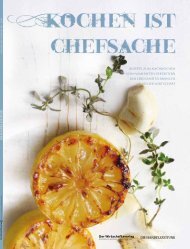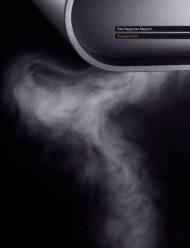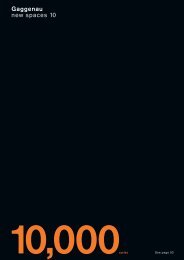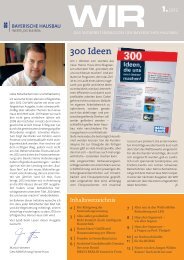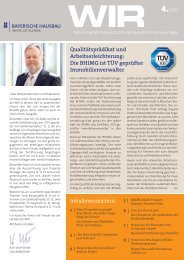new_spaces_07_GB
You also want an ePaper? Increase the reach of your titles
YUMPU automatically turns print PDFs into web optimized ePapers that Google loves.
50 Thinking the Future III<br />
and pure cynicism? Starck explains: “I designed the lamps<br />
because I’m a pacifi st. I wanted to highlight the excessive<br />
violence in our society.” Fine — but whether you see it that way<br />
is a personal question.<br />
One thing that storytelling in design, including Starck’s<br />
gun lamps, certainly accomplishes is a shift away from pure<br />
functionalism to sensuality. This is also the lesson of the<br />
funicular railway stations designed by Zaha Hadid in Hungerburg<br />
near Innsbruck. Interestingly, an earlier creation by the<br />
English-Iraqi architect is only a few kilometres away. Although it’s<br />
only eight years old, the Bergisel Ski Jump is from another technological<br />
age compared to the four funicular stations of 20<strong>07</strong>.<br />
Here we see minimalist shotcrete, as compared to the futuristic<br />
glass façades in Hungerburg, which are shaped like huge manta<br />
rays and illuminated at night with high-tech LED lighting. Yet very<br />
simple design can also tell a story. Take the feathery Icarus lamp<br />
by Tord Boontje: A swan’s wing is wrapped around the light,<br />
nothing more. The Dutch designer describes his work as a “delicate<br />
marriage of design and emotion” and explains that “modern<br />
design doesn’t have to mean minimalism.” Like the Campana<br />
brothers, Boontje plays with different combinations: vases made<br />
of paper, furniture made of pieces of old wood. Everything is<br />
allowed, nothing is mandatory. Fellow Dutchman Maarten Baas<br />
takes an equally relaxed approach. He fi rst achieved fame with<br />
his charred Louis XVI furniture, which, set alongside the shiny<br />
creations of the design galleries, looks like a relic from a<br />
forgotten chateau. With ideas like “Hey, chair, be a bookshelf,”<br />
Baas takes design one step further than pure storytelling, by no<br />
longer importing stories into design, but rather creating stories<br />
through design. Perhaps the simplest way to tell a story with<br />
furniture is simply to plaster furniture with stories. That’s just<br />
what Giuseppe Canavese did when he papered cupboards and<br />
dressers with scenes from his favourite comic strip starring the<br />
1960s icon Valentina. Bedroom furniture, appropriately enough,<br />
is decorated with an alarm clock. The Italian designer has a<br />
playful approach to the history of art and design, combining<br />
Roy Lichtenstein’s use of comic strips with Gio Ponti’s 1950’s<br />
retro chic. There are no limits to the kinds of stories that<br />
design can tell, except perhaps the designer’s own imagination.<br />
And when it comes to Ora-ïto, imagination knows no<br />
bounds. As a young, inventive but still unsuccessful designer,<br />
he dreamt up <strong>new</strong> products for Louis Vuitton, Swatch and Apple<br />
without being commissioned to do so, and then posted them on<br />
the Internet. The response was overwhelming: Thousands of<br />
people tried to order his creations in the brands’ shops. Suitably<br />
impressed, the brands promptly awarded him design contracts.<br />
What started as a design story ended as a designer fairytale.<br />
Today the talented young designer is involved in a range of<br />
projects, including a kitchen that recalls the fi lm 2001: A Space<br />
Odyssey. Or it does so, at least, when you look at it with your<br />
eyes wide open. And that is really all you need to do in order to<br />
read design stories.<br />
Further information<br />
www.tordboontje.com<br />
www.maartenbaas.com<br />
www.moooi.com<br />
www.marcelwanders.com<br />
www.vam.ac.uk/microsites/telling-tales<br />
www.dillerscofi dio.com<br />
www.demakersvan.com<br />
www.piekebergmans.com<br />
Twisted around its own axis<br />
In order to construct Santiago Calatrava’s<br />
“Turning Torso” in Malmö, Sweden (left),<br />
<strong>new</strong> processes had to be developed<br />
to produce the surreally distorted windows.<br />
Light poured in a molten drop<br />
Pieke Bergmans’ “Light Blub” (right).



